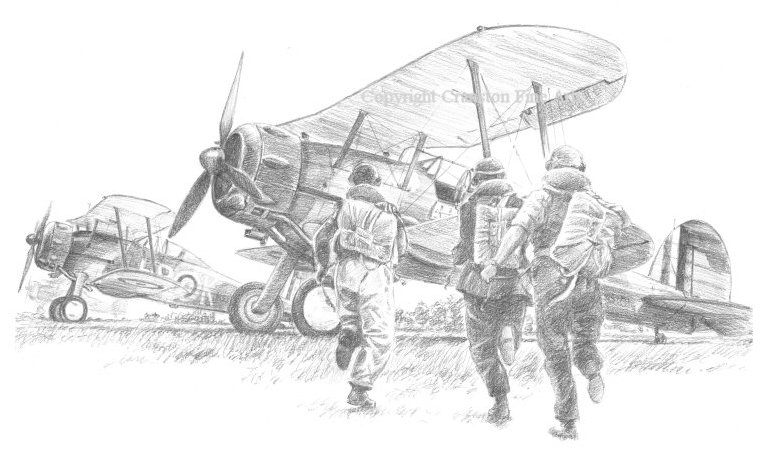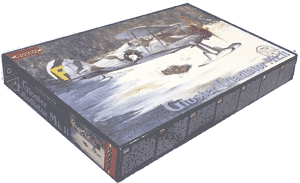Move from Sumburgh Fighter Flight to 247 Squadron RAF Roborough around July 1940

Sumburgh Fighter Flight that transferred as 247 Squadron to RAF Roborough (includes N.I.C.Francis?)
No.
247 (China British) Squadron
http://www.the-battle-of-britain.co.uk/squadrons/Sq-crests/247-Sqdrn.gif
"Rise from the east"
http://www.military-art.com/mall/images/800s/b0377.jpg
The
Gloster Gladiator HP-B of No.
247
Sqd.
in
the fall of 1940 off the coast of SW England
Thursday,12th August 1940, 399 Tavistock Road, Plymouth Roborough
5:54
Tired I lift, Flight Lieutenant George F. Chater born in Durban / South Africa,
my gaze from the unpleasant paperwork and look out the window of Tea Rooms of
requisitioned "George Hotel".
Outside awakens a new day, it's still summer, the fruits in the hotel's garden
are slowly maturing.
Ripe
and ready for use now seems the No.
247th, MY, Squadron.
10-ready pilots, including myself are ready to Southwest England to the whole of
Wales in the composite squadrons of No.
10th
Fighter Group, to defend against the daily raids by the German Luftwaffe.
Time
to leave again circling the views of all relevant key points:
No.
247
Squadron
My Squadron has only been 12 days.
On
01 August, it was put into service officially on RAF Roborough.
The
motto of our squadron I have appointed to a unit internal ideas competition
"Rise from the east" because our equipment was procured by vigorous help of
donations from collections in the Chinese colonies His Majesty among others.
We honour the loyal subjects in the Far Eastern colonies and want to prove to us
their sacrifice worthy!
The
core of our season is the result of the "Shetland Fighter Flight", which I
belong to, since December 39, and which I was allowed to run ever since.
At
RAF Sumburgh we have since winter 39/40 German reconnaissance and combat
aircraft, which had the naval bases of the North goal intercepted.
Our
Fighter Flight in turn was before the B-Flight of No.
152
Squadron sprung.
Equipped with the old but reliable Gloster Gladiator Mk.II we have our best
attempts to keep the Huns of the fleet.
The
only countable result was the launch of a Do-17 by Thomas William "Jock" Gillen
on 05.06.1940 (this launcher message could by no loss record an official Air
Force document to be confirmed, but a Lockheed Hudson of No. been since that
date in the said region 233 Sqd missing., probably therefore a case of
friendly-fire).
http://surfcity.kund.dalnet.se/images/gillen_1.jpg
F
/ O Gillen, right in the picture
At
18:07.
came
the laying instruction by RAF Roborough in the Devonshire countryside in order
to protect the southwest of the Kingdom with the important fleet ports Plymouth
and Falmouth and their essential war docks before the bombing of the Air Force.
Since the increase in German air raids on British territory in July 1940, more
and more fighter squadrons were moved to the southeast so that air defence was
always full of holes in the southwest.
However, even here the attacks German associations grew increasingly.
At
21:07.
We arrived with our gladiators in Roborough, place were other machines of the
same type, usually there were Mk.II, camouflaged loosened and roughly around.
Our
hope of being able to take with the relocation to the south and a new device,
not fulfilled.
Somewhat disgruntled we took the standing around Gloster possession.
Some
of them were in such a bad condition that one would assume that they had
participated in the 100th still war.
After 10 days of painstaking work, the newly ragtag ground personnel in addition
to the 5 Gladiator Mk.II the original Shetland Fighter Flights 5 more Gloster
for "enthronement" of No.
can
make 247 ready.
More
are in the works, the rest are only good as a source of spare parts!
Currently were more clear messages true luxury because only 10 drivers are
available.
I
have sent an urgent request to supply new pilots to RAF Filton (our sector
command), we were short Nachersatz assured.
Let
us surprise.
http://www.crashsiteorkney.com/userimages/gladiatorpilotssumburgh.jpg
My
men!!
Division for the time being:
A-Flight: F / L GF Chater / P / O NIC Francis / Sgt H. Makin / Sgt E. Trent..
B-Flight: F / L RA Hooks / P / O RA Winter / Sgt F. Jeffries.
C-Flight: F / O TW Gillen / P / O NAR Doughty / Sgt G. Greenwood.
The
aim is to equip all Flights 4 gladiators.
In
addition to still a reserve pool (R-Flight) of 4 machines and if possible also
arise another Reserve pool of pilots.
--------------------------------------------------------------------------------
Along with F / L Hooks, F / O Gillen and P / O Francis I sprint to the machines of the A-Flights.
Http://www.military-art.com/mall/images/800s/dp0189p.jpg

--------------------------------------------------------------------------------
ORIGINAL WEB SITE - P/O FRANCIS MENTIONED MULTIPLE TIMES: (COPY AND PASTE WHOLE LINE IN BROWSER to view in english)
https://translate.google.co.uk/translate?hl=en&sl=de&u=http://www.si-games.com/forum/archive/index.php/t-23196.html&prev=search

Gloster Gladiator N5585 - Anzac - usually Flown By Pilot Officer N.I.C.Francis on 247 Squadron

Under the cockpit is a kangaroo superimposed on a map of Australia, the text
'Anzac Answer' and a kill marking. Why?
There are two possibilities quoted for this aircraft operated by 247 Squadron
RAF and usually piloted by a Briton (PO NIC Francis) which are
1. Australian ace Pat Hughes was temporarily assigned from 234 Squadron to 247
at the time they had Gladiators.
2. 247 flew escort for 10 Squadron RAAF Sunderland's.
Roden Gloster Gladiaror Model Page - note Decals for P/O N.I.C.Francis N5585 aircraft:
|
|
|||
 |
 |
||
|
|||
  |
|||
|
|||
| Technical Specifications | |
| Wing Span | 9,83 m |
| Total Length | 8,40 m |
| Wing area | 30,01 m2 |
| Take off weight | 2206 kg |
| Speed (max) | 414 km/h |
| Service ceiling | 10210 m |
| Range | 689 km |
| Powerplants | 1xBristol Mercury VIII 830 h.p. |
| Armament | 4x0,303(7,7)mm machine guns |
